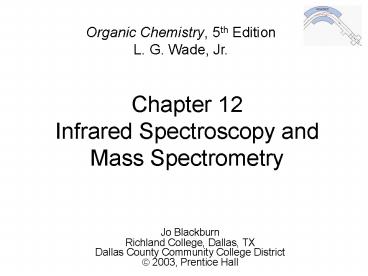Chapter 12 Infrared Spectroscopy and Mass Spectrometry - PowerPoint PPT Presentation
1 / 42
Title:
Chapter 12 Infrared Spectroscopy and Mass Spectrometry
Description:
Spectroscopy is an analytical technique used to helps determine the ... Correspondence with a known sample's IR spectrum confirms the identity of the compound. ... – PowerPoint PPT presentation
Number of Views:154
Avg rating:3.0/5.0
Title: Chapter 12 Infrared Spectroscopy and Mass Spectrometry
1
Chapter 12 Infrared Spectroscopy and Mass
Spectrometry
Organic Chemistry, 5th EditionL. G. Wade, Jr.
Jo Blackburn Richland College, Dallas, TX Dallas
County Community College District ã 2003,
Prentice Hall
2
Introduction
- Spectroscopy is an analytical technique used to
helps determine the structure of a molecule. - The amount of light absorbed by the sample is
measured as the wavelength is varied. - Advantage - It destroys little or no sample in
the analysis.
3
Types of Spectroscopy
- Infrared (IR) spectroscopy determines the bond
vibration frequencies in a molecule and is used
to identify the functional group(s). - Ultraviolet (UV) spectroscopy uses electron
transitions between orbitals to determine bonding
patterns. - Nuclear magnetic resonance (NMR) spectroscopy
detects signals from hydrogen and other atoms and
can be used to structurally identify unknown
compounds. - Mass spectrometry (MS) fragments the molecule and
measures the masses of the pieces.
4
The Spectrum and Molecular Effects
gt
5
IR - Molecular Vibrations
- Covalent bonds vibrate at only certain allowable
frequencies.
6
Vibrational Modes
- Nonlinear molecule with n atoms usually has 3n -
6 fundamental vibrational modes.
7
Vibration of Methylamine
8
Fingerprint of Molecule
- No two molecules will give exactly the same IR
spectrum (except enantiomers). - Simple stretching 1600-3500 cm-1.
- Complex vibrations 600-1400 cm-1, called the
fingerprint region.
9
IR-Active and Inactive
- A polar bond is usually IR-active.
- A nonpolar bond in a symmetrical molecule will
absorb weakly or not at all.
10
An Infrared Spectrometer
11
Carbon-Carbon Bond Stretching
- Stronger bonds absorb at higher frequencies
- C-C 1200 cm-1
- CC 1660 cm-1
- C?C 2200 cm-1 (weak or absent if internal)
- Conjugation lowers the frequency of CC
vibrations - isolated CC 1640-1680 cm-1
- conjugated CC 1620-1640 cm-1
- aromatic CC approx. 1600 cm-1
12
Carbon-Hydrogen Stretching
- Bonds with more s character absorb at a higher
frequency. - sp3 C-H, just below 3000 cm-1 (to the right)
- sp2 C-H, just above 3000 cm-1 (to the left)
- sp C-H, at 3300 cm-1
13
An Alkane IR Spectrum
14
An Alkene IR Spectrum
15
An Alkyne IR Spectrum
16
O-H and N-H Stretching
- Both of these occur around 3300 cm-1, but they
look different. - Alcohol O-H, broad with rounded tip.
- Secondary amine (R2NH), broad with one sharp
spike. - Primary amine (RNH2), broad with two sharp
spikes. - No signal for a tertiary amine (R3N)
17
An Alcohol IR Spectrum
18
An Amine IR Spectrum
19
Carbonyl Stretching
- The CO bond of simple ketones, aldehydes, and
carboxylic acids absorb around 1710 cm-1. - Usually, its the strongest IR signal.
- Carboxylic acids will have O-H also.
- Aldehydes have two C-H signals around 2700 and
2800 cm-1.
20
A Ketone IR Spectrum
21
An Aldehyde IR Spectrum
22
Variations in CO Absorption
- Conjugation of CO with CC lowers the stretching
frequency to 1680 cm-1. - The CO group of an amide absorbs at an even
lower frequency, 1640-1680 cm-1. - The CO of an ester absorbs at a higher
frequency, 1730-1740 cm-1. - Carbonyl groups in small rings (5 Cs or less)
absorb at an even higher frequency.
23
O-H Stretch of a Carboxylic Acid
- This O-H absorbs broadly, 2500-3500 cm-1, due to
strong hydrogen bonding.
24
Carbon - Nitrogen Stretching
- C - N absorbs around 1200 cm-1.
- C N absorbs around 1660 cm-1 and is much
stronger than the C C absorption in the same
region. - C ? N absorbs strongly just above 2200 cm-1. The
alkyne C ? C signal is much weaker and is just
below 2200 cm-1 .
25
An Amide IR Spectrum
26
A Nitrile IR Spectrum
27
Summary of IR Absorptions
gt
28
Strengths and Limitations
- IR alone cannot determine a structure.
- Some signals may be ambiguous.
- The functional group is usually indicated.
- The absence of a signal is definite proof that
the functional group is absent. - Correspondence with a known samples IR spectrum
confirms the identity of the compound.
29
Mass Spectrometry
- Molecular weight and structural information can
be obtained from a very small sample. - It does not involve the absorption or emission of
light. - A beam of high-energy electrons breaks the
molecule apart. - The masses of the fragments and their relative
abundance reveal information about the structure
of the molecule.
30
Electron Impact Ionization
- A high-energy electron can dislodge an electron
from a bond, creating a radical cation (a
positive ion with an unpaired e-) and other
radical and cationic fragments.
31
Mass Spectrometer
32
The GC-MS
A mixture of compounds is separated by gas
chromatography, then identified by mass
spectrometry.
33
High Resolution MS
- Masses measured to 1 part in 20,000.
- A molecule with mass of 44 could be C3H8, C2H4O,
CO2, or CN2H4. - If a more exact mass is 44.029, pick the correct
structure from the table
34
The Mass Spectrum
- Masses are graphed or tabulated according to
their relative abundance.
35
Isotopic Abundance
36
Mass Spectrum with Sulfur
37
Mass Spectrum with Halogens
38
Mass Spectra of Alkanes
- More stable carbocations will be more abundant.
39
Mass Spectra of Alkenes
- Resonance-stabilized cations favored.
40
Mass Spectra of Alcohols
- Alcohols usually lose a water molecule.
- M may not be visible.
41
Mass Spectra of Ethers
42
End of Chapter 12































